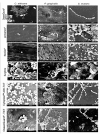In Vitro Microbial Adhesion on the Surfaces of Various Polytetrafluoroethylene Membranes Used in Guided Bone Regeneration
- PMID: 40710146
- PMCID: PMC12293225
- DOI: 10.3390/dj13070301
In Vitro Microbial Adhesion on the Surfaces of Various Polytetrafluoroethylene Membranes Used in Guided Bone Regeneration
Abstract
Aim: The aim of this study was to evaluate the adhesion of oral microorganisms on the surfaces of polytetrafluoroethylene (PTFE) membranes used in guided bone regeneration (GBR) procedures. Materials and Methods: In this study, three oral microorganisms (Streptococcus mutans, Porphyromonas gingivalis, and Candida albicans) were used, and six PTFE membranes were characterized by their surface roughness, contact angle (CA), and surface free energy (SFE). Microbial hydrophobicity was investigated, and adhesion was examined via DNA extraction and quantitative real-time PCR. Results: Significant differences were noted amongst the membranes with respect to SFE, CA, and roughness (p < 0.001). S. mutans was the most hydrophobic microorganism, followed by C. albicans and P. gingivalis. SEM analyses confirmed that the microorganisms adhered to all membranes, with Surgitime being the membrane that attracted the highest number of S. mutans (p < 0.001) and P. gingivalis (p < 0.001). By contrast, OsseoGuard-TXT was one of the membranes that attracted the lowest number (p < 0.001) of all three tested species. Conclusions: The results showed that microbial adhesion to PTFE membranes was affected by the membrane surface roughness and SFE, as well as the characteristics of the microorganisms. The most hydrophilic bacteria adhered the least to all the tested membranes, whereas membranes with a low surface roughness and high SFE attracted the lowest number of all the tested microbes. These results may guide the selection of an appropriate GBR membrane.
Keywords: C. albicans; P. gingivalis; PTFE; S. mutans; bone regeneration (guided)/GBR; membranes; microbial attachment; surface free energy.
Conflict of interest statement
The authors declare no conflicts of interest.
Figures




References
-
- Zheng S., Bawazir M., Dhall A., Kim H.E., He L., Heo J., Hwang G. Implication of Surface Properties, Bacterial Motility, and Hydrodynamic Conditions on Bacterial Surface Sensing and Their Initial Adhesion. Front. Bioeng. Biotechnol. 2021;9:643722. doi: 10.3389/fbioe.2021.643722. - DOI - PMC - PubMed
Grants and funding
LinkOut - more resources
Full Text Sources

